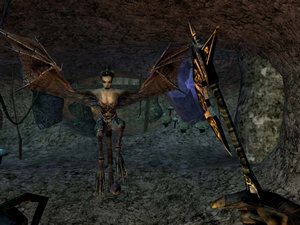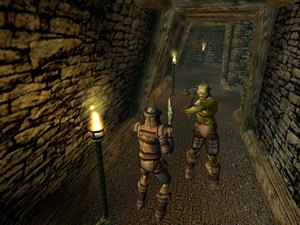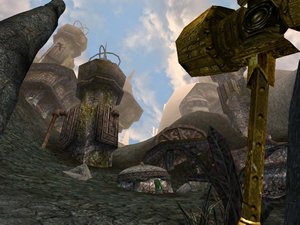Size matters…as does stability.
I can still remember how blown away I was by the game Daggerfall.
Despite its clunky graphics, this was a game that totally revolutionized single-player
role-playing by presenting a massive world that allowed you to do just about anything.
I even watched with glee as a friend got bit by a vampire…only to turn into
one himself, taking on the powerful abilities and unfortunate detriments to being
undead.
It has been a long time since Daggerfall came out, and I’ve tried to
wait patiently for a follow-up (the forgettable Battlespire
doesn’t count). And after seeing The Elder Scrolls III: Morrowind demoed
at two E3 trade shows, I knew that the minds behind one of the most important
RPGs ever were determined to update their series with style.
For
the most part, they nailed it. At its core, Morrowind is a terrific game,
one that really shows off the power of an astoundingly huge, nearly limitless
game world and the freedom it gives the gamer. But I didn’t figure this out
for quite some time, as the game is plagued with a slew of compatibility bugs
that made it all but impossible to play on my machine of choice.
Morrowind is the third in the Elder Scrolls series, following the ancient
Arena and the classic Daggerfall. It’s very much in the tradition
of these games in terms of programming, freedom and open-ended gameplay, though
it ups the ante in terms of delivery.
I think the best way to describe Morrowind is that it’s really built
for you to explore, not for you to complete. The start of the game is great.
You arrive in the land of Vvardenfell by ship, a lowly outlander just trying
to survive. At this point, you don’t know who you are at all. Soon enough, you’ll
have to check in at the Census office and by way of seamlessly interwoven question
and answer, pick your race, gender, class and birth sign.
You’ll know that things are different here when you consider the whopping
10 races to choose from, each with distinct abilities and attributes. That’s
further specialized when you pick a class. Morrowind gets brownie points
for including a very clever option that has you answering a list of moral questions
in order to determine what class best suits you. Alternately, you can pick your
own or mix and match, a daunting task for any but the most hardcore gamer.
However, you can’t really choose incorrectly, as the game breaks down the
confinements of the class system by rewarding repetition, much in the same way
as Ultima Online. With practice,
a mage can learn to use an axe. A thief can learn to cast fireballs. It won’t
be easy (though you can probably find someone willing to train you for some
coin), but any type of race or class can master any skill set in the game.
To counter this, Morrowind features a trillion skills, ranging from
the obvious like ‘Long Sword’ and ‘Destruction Spells’ to obscure abilities
like ‘Mercantile’ (haggling) and ‘Alchemy.’ Take some mushrooms, buy (or steal)
a mortar and pestle, and try making some potions. Drinks are on the house!
Once you’re set with your character, you’re on your own. Literally. You’re swept out into the street with a note to deliver to a guy in a town far away, which does give you some direction, but you don’t remotely have to follow it.
In fact, you don’t have to do anything. Want to stroll around the countryside
picking mushrooms? Go ahead. Want to take a swim? Have a blast. Feel like stealing
a sword from a shopkeeper? Feel free! Er, provided you’re willing to pay the
consequences should you fail, which means either paying off your sin in gold
or spending some time in lockup, which degrades your skills a tad.
 Yep,
Yep,
that’s right. Jail. You can be a bad guy if you want, robbing and maiming the
innocent. The game is geared to just allow you to exist however you see fit,
and though there are obvious benefits to being good over being evil, you can
be either and succeed all the same. The point here is that you do not have to
follow any specific path in this game. You can pretty much take any road you
wish… and Morrowind will fill it with things for you to do.
Speaking of roads, there are lots of them. Vvardenfell is simply gigantic,
featuring literally hundreds of towns, cities, farms, caves, forts, tombs, dungeons
and more. To give you a sense of the size and scope of this game, I spent well
over 40 hours playing Morrowind, only actually seeing about 6 cities
spanning areas covering roughly one quarter of the game world. I’ve done a lot,
for sure – my Dark Elf will kick your ass – but at the same time I have hardly
scratched the surface.
Every single city is populated with unique characters with unique stories, names and looks. Though obviously there’s some repetition here, there are enough quests in the game to make every area feel different and important.
And you can be sure that you’ll undertake plenty of quests, but not all of
them will have to do with the Main Story. Actually, very few of them have anything
to do with the plot (yes, there is a plot tucked away here somewhere). You might
join a guild (Mage’s, Fighter’s, Thieves) and run errands to increase your rank.
You might want to become an Imperial officer, or a Knight protector, or a Temple
priest, or none of the above. Again, it’s up to you.
On the other hand, all this freedom comes at a cost – too many choices. This
is a frightening game for gamers who like direction. There will definitely be
some of you who will turn the game on, get spit out into the street, wander
around for a bit and eventually get bored because the game isn’t creating enough
drama for you on its own.
This isn’t helped by the fact that the game employs no FMV at all to flesh
out important plot points. You don’t get rewarded with cut scenes or get big
panoramic sweeps of new areas. The lack of these classic plot devices takes
away from the story of Morrowind and can lead to a game that feels a
little redundant.
This enormous world is shown to you through either a first or third person
camera, both of which are useful. The control is essentially that of a first-person
shooter and works well. You’ll run around swapping through menus with ease,
and the screen is rarely cluttered with nonsense. It’s clean and functional.
 The
The
same can be said for the graphics. Morrowind looks nice and will take
advantage of your fancy 3D card…and you better make sure you have one, because
this game is a monster when it comes to resources. Gamers with mid-range rigs
might find sluggish framerates, provided they even get the thing running.
This is a real shame. I tried getting Morrowind working on my home PC,
a 1 Ghz Thunderbird with a Geforce 2 and 512 MB RAM. I’ve played countless PC
games on it and have never really had any significant problems, but Morrowind
simply refused to run at all, despite weeks of effort through the (quite pleasant)
Bethesda tech support staff. Eventually, I gave up and got it working on the
GR office rig.
I should note here that these compatibility problems aren’t found in the Xbox
version of the game, which came out a few weeks after the PC version. Seems
like they took the time to iron out the bugs for the console release since they
knew they couldn’t patch it. Argh.
The entire game is real-time, so combat essentially boils down to flat out
action. This is one of the game’s poor spots. Most melee combat is easier in
first-person thanks to a targeting reticule, which means you’re moving towards
and away from your opponent just swinging like mad. There are a few different
types of swings based on how long you hold down the mouse button, but there
are no advanced moves or combos at all. This is sort of a letdown, as combat
can wind up a bit mundane and a little too much like a first-person Diablo.
The combat also brings up the game’s most irritating omission – a lack of
any sort of hit point meter for enemies. Sure, my Fiend Katana does up
to 20 points of damage, but why is that info useful if I don’t even have a little
meter to watch as I smite my foe? You’ll know you hit ’em, but you’ll have no
idea how much damage you did or how close the baddies are to dying. It gets
frustrating…and the developers knew it, since they have fixed it in this version
thanks to a patch. Unfortunately, we review games straight out of the box, not
after being patched. A little late, guys.
Though we here at GR go off all the time about the lack of voice-acting in
RPGs, it’s sort of hard holding that against Morrowind because of the
amount of information it contains. Every single character in the game – thousands,
easy – has a voiced greeting. A few of the key players have more elaborate speech,
but the bulk of the time you’ll be reading text. It can admittedly get tiresome,
but again, there’s just hours and hours of stuff to soak up. You can read every
book you might find in the game (there are a LOT of books), some of which have
close to 50 pages detailing past events in the universe that have no bearing
on gameplay at all.
The rest of the sound is fine, with epic, sweeping music and decent effects.
The PC version of Morrowind also comes packed with the TES Construction
set, which allows you to design your own areas, items, characters, etc.. It’s
very powerful, but also very clunky. You’ve got to be pretty hardcore to spend
enough time to learn how to use it efficiently. Besides, there’s so much in
the actual game to explore, it almost seems like overkill.
There’s much more to Morrowind than is covered in this review, such
as the impressive numbers of unique items, the thrill of murdering an innocent
and getting away with it, and the fact that you can even make your own spells.
If you can get it working and have a great computer, then it’s an easy recommendation.
However, be prepared for the worst, as the Elder Scrolls tech support forum
is overflowing with user complaints about compatibility issues. At any rate,
this is still the biggest, deepest, most detailed RPG to hit the PC since Daggerfall,
and for that, earns high marks.

-
What a world, what a world
-
Giganto-enormous!
-
Total freedom
-
You can be a jerk
-
Incredible depth
-
So many choices!
-
Too many choices?
-
Combat problems
-
Can feel repetitive
-
Just too buggy









